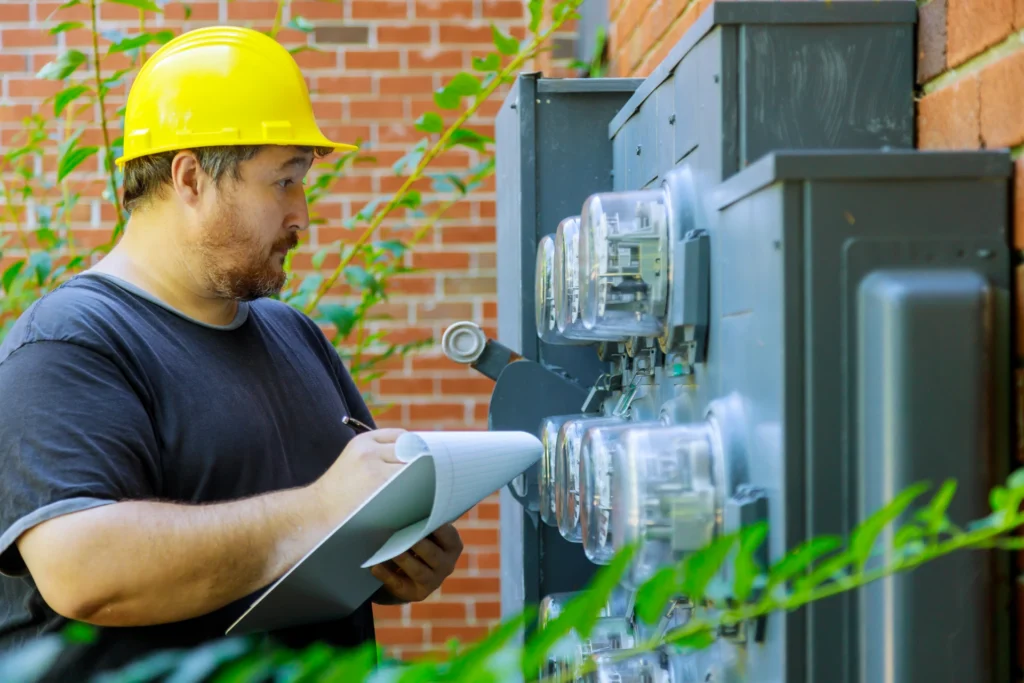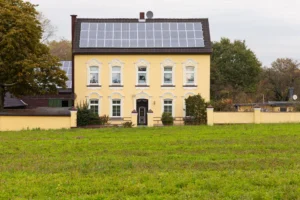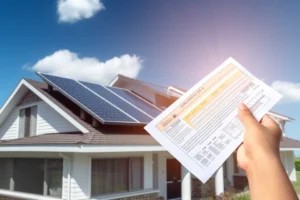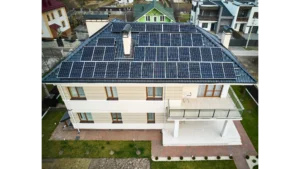
Solar energy as a sustainable power source has grown in popularity recently. Many homeowners are interested in installing solar panels to reduce their reliance on traditional sources of electricity and lower their carbon footprint. However, before switching to solar power, it is important to understand how much energy your home requires and how many solar panels will be needed to meet that demand.
Calculating the amount of energy necessary for powering a home with solar panels can seem like a daunting task. It involves understanding your current energy usage and assessing your home’s potential for generating solar power, selecting the right panel type, estimating costs, and hiring professional installers. With careful planning and consideration, however, converting your home to solar power can provide an environmentally-friendly and cost-effective solution for meeting your daily energy needs.
The first step in calculating the energy required to power a home with solar panels is to comprehensively understand the household’s energy needs. Understanding energy consumption is critical in designing a solar panel system that will meet your household’s energy requirements. The most effective way to comprehend this is by conducting an energy audit, which involves inventorying how much energy you use throughout your home.
During an energy audit, you can identify areas where excessive energy consumption occurs and devise strategies to reduce it. Reducing energy waste in your home saves you money on electricity bills and helps ensure that your solar panel system won’t be unnecessarily oversized, reducing installation costs. Simple steps such as replacing incandescent bulbs with LED lamps or upgrading old appliances to newer models with higher efficiency ratings can significantly reduce electricity usage.
Furthermore, understanding peak power demand is essential when designing a solar panel system. Your peak power demand refers to the highest amount of electrical power consumed simultaneously in your home, typically during hot summer days when air conditioners run at full capacity. Knowing this information allows for proper sizing of your solar panel system and battery storage capacity to have enough electricity even during high-demand periods.
Understanding the unique energy needs of your household through an extensive audit and identifying ways to reduce unnecessary consumption are crucial steps before installing a solar panel system. This process ensures you design an optimal solution for meeting those specific needs while maximizing cost savings and minimizing environmental impact in the long run.
Evaluating the solar potential of a residential property is essential in determining its ability to generate electricity from sunlight. Conducting a site evaluation, homeowners can determine if their homes are suitable for solar panels. A site evaluation involves assessing various factors such as the orientation of the roof, available space, and shading analysis.
The shading analysis is an important aspect of evaluating a home’s solar potential. Shaded areas on a rooftop can significantly reduce the amount of energy that solar panels can generate. It’s, therefore, crucial to assess all potential sources of shade around the house, including trees and nearby buildings. Homeowners should also consider seasonal changes in sun exposure and evaluate how much these changes will impact their solar panel system.
When conducting a site evaluation, it’s essential to consider other factors that may affect solar panel output. These include weather patterns like cloud cover and temperature variations throughout the day. Additionally, homeowners must consider any obstructions or barriers preventing sunlight from reaching their panels.
Assessing your home’s solar potential is crucial when considering switching to renewable energy by installing solar panels. Conducting a thorough site evaluation incorporating shading analysis and other relevant factors helps homeowners determine whether their properties are suitable for generating electricity from sunlight. This knowledge enables them to make informed decisions about investing in renewable energy systems that best meet their energy needs while reducing environmental impact over time.
When considering installing a solar panel system, one important decision is choosing the appropriate type of panel for your specific location and needs. Many types of solar panels are available on the market, each with unique features and characteristics. One important factor to consider when selecting a panel is its efficiency rating. The efficiency rating measures how much sunlight the panel converts into electricity. A higher efficiency rating means more solar energy will be converted into usable electricity, which can translate into lower costs over time.
Another important consideration when selecting a solar panel is durability. Solar panels are exposed to harsh weather conditions such as wind, rain, hail, and snow. Therefore, choosing a durable panel that can withstand these elements over time without losing its effectiveness or needing frequent maintenance is crucial. Durability comparisons should be made among different types of panels before making a final selection.
Beyond efficiency and durability, there are other factors to consider when selecting a solar panel type. For instance, some panels may be better suited for specific applications such as rooftop installations or ground-mounted systems. Others may have additional features like built-in microinverters or monitoring software to enhance performance or simplify maintenance tasks.
Selecting the right type of solar panel for your home requires careful consideration of several factors, including efficiency rating and durability comparison among different types available in the market today. By taking these factors into account, along with other considerations like application-specific requirements or additional features offered by certain types of panels, you’ll be able to choose an appropriate option that meets your needs while maximizing cost savings over time through reduced energy bills and increased sustainability efforts at home!
Estimating the cost of a solar panel system entails calculating the total system cost, accounting for incentives and tax credits, and considering financing options. Total system cost includes the price of solar panels, installation fees, and any additional equipment required to connect to the grid. Incentives such as rebates and tax credits can reduce the overall cost of a solar panel system, while financing options like leases or loans can make it more affordable in the short term.
Calculating the total system cost is essential in determining the energy needed to power a home with solar panels. This step involves analyzing the costs of setting up a solar system, including equipment costs, labor costs, and permitting fees. By estimating these costs accurately, homeowners can determine whether switching to solar power is financially feasible.
Estimating payback is an important factor to consider when calculating the total system cost. This refers to how long it will take for the savings on energy bills from using solar power to offset the initial investment in setting up a solar system. Homeowners should also compare financing options to determine which option best suits their financial situation. For example, some states offer incentives or tax credits for switching to solar power that may make financing more affordable. By considering all factors in estimating the total system cost, homeowners can make informed decisions about whether installing a solar panel system is worth it for them regarding financial benefits and environmental impact.
Maximizing available incentives and tax credits can significantly reduce the overall cost of implementing solar panel systems, making it a more financially viable option for those seeking to reduce their carbon footprint. Incentives and tax credits are offered at federal, state, and local levels, so it’s important to research which programs you may be eligible for. Some incentive eligibility criteria include income limitations, system size requirements, and specific equipment or installation standards.
To take advantage of these incentives and tax credits, it’s important to understand the application process. The federal government offers a Residential Renewable Energy Tax Credit that allows homeowners to claim 26% of the total cost of their solar system as a credit on their taxes. To apply for this credit, homeowners must fill out IRS Form 5695 when filing their taxes. State and local incentives may have different application processes, so it’s important to research each program thoroughly before beginning the installation process. By taking advantage of available incentives and tax credits, homeowners can significantly reduce the upfront costs of implementing solar panels in their homes while contributing to a cleaner energy future.
One important aspect to consider when implementing solar panel systems is exploring different financing options. While purchasing a solar system outright may be the most cost-effective option in the long run, it also requires a significant upfront investment that not everyone can afford. Financing options such as solar loans or leases can help make solar power more accessible by allowing homeowners to pay for their systems over time.
When considering financing options, it’s important to weigh the pros and cons of each option and find the right lender for your needs. Solar loans typically offer lower interest rates than traditional personal or credit cards but may require a higher credit score for approval. On the other hand, leasing allows homeowners to enjoy the benefits of solar power without any upfront costs or maintenance responsibilities. Still, it may result in higher overall costs in the long run. Finding a reputable lender who understands your financial situation and goals can help you decide which financing option is best for you.
Hiring a professional solar installer is recommended for those unsure how to properly install solar panels in their home. Finding reputable installers and comparing installation quotes can help you choose the best one for your needs. A professional installer will have the knowledge and experience to ensure your solar panel system is installed correctly and safely.
When hiring a professional solar installer, it’s important to do your research. Look for companies with good reviews and a proven track record of successful installations. You may also ask friends or family members who have installed solar panels for recommendations.
Once you’ve found a few potential installers, get quotes from each. Compare the prices and services offered by each company before making a decision. Remember that the cheapest option may not always be the best choice – consider factors such as experience, reputation, and customer service.
In addition to ensuring that your solar panel system is properly installed, hiring a professional can also save you time and hassle. They will take care of all aspects of the installation process, from obtaining permits to connecting your system to the grid. This means you can sit back and relax while enjoying the benefits of clean, renewable energy in your home.
To ensure a smooth and legal installation process, obtaining the necessary permits and approvals from local authorities is crucial when installing a solar panel system. Before starting any work, it is important to understand the permit application process and requirements in your area. This may involve submitting an application that includes detailed information about your project, such as the panels’ location, size, and how they will be mounted.
Zoning regulations can also impact your solar panel installation by dictating where you can place your panels on your property. Some areas may have specific setbacks or height restrictions that must be followed. It is important to research these regulations beforehand to avoid any potential conflicts or issues during the installation process.
In addition to zoning regulations, building codes may need to be followed for safety reasons. These codes may include requirements for electrical wiring and grounding systems designed to protect people from electrocution or fire hazards.
Overall, obtaining permits and approvals is essential to installing a solar panel system. By understanding the permit application process and researching zoning regulations and building codes in advance, you can ensure a smooth and successful installation while complying with all necessary legal requirements.
Installing a solar panel system requires careful planning and execution to ensure maximum efficiency and effectiveness. The process begins with mapping out the placement of panels and determining optimal angles for capturing sunlight. Once this is done, the physical setup of the system can begin, including connecting wiring and mounting the panels securely so that they are not damaged by wind or other environmental factors. Finally, a thorough inspection and testing process should ensure that all components work properly and that the system generates enough energy to meet your needs.
One crucial step in installing solar panels is carefully planning the layout and orientation to optimize energy production. This involves considering budget considerations, safety precautions, and other factors that may affect the system’s efficiency. The following are some important considerations when planning for a solar panel installation:
By carefully considering these factors during the planning phase, homeowners can ensure an efficient and effective solar panel installation that meets their energy needs while minimizing costs and maximizing long-term benefits.
Setting up a solar panel system requires careful attention to detail, including proper equipment installation and connection of electrical components. Before beginning the installation process, it is important to gather all the necessary materials and tools required for the job. These include solar panels, mounting hardware, wiring, an inverter, batteries (if using a battery-based system), and safety equipment such as gloves and goggles.
When installing a solar panel system on your own, several tips can help you avoid common mistakes. First, ensure that you have properly mounted your solar panels in a location that receives sufficient sunlight throughout the day. Next, be sure to connect all electrical components correctly to avoid damage or failure of the system. It is also important to regularly monitor your system’s performance and make any necessary adjustments or repairs along the way. Following these tips for DIY installation can help ensure that your solar panel system is set up correctly and functions efficiently for years to come.
To ensure the optimal performance and safety of a solar panel system, it is necessary to conduct regular testing and inspection. Testing procedures should be conducted regularly to identify any potential issues that might impact the system’s performance. One important test is measuring each solar panel’s output voltage and current in the array to ensure they are all producing energy at their rated capacity.
Equipment maintenance is also crucial for the longevity and efficiency of a solar panel system. Regular cleaning of panels ensures that there isn’t any buildup of dirt or debris that can reduce their energy production. Inspecting wiring connections, inverters, batteries, and other components for signs of wear or damage can help prevent costly repairs or replacements. By conducting these tests and regularly maintaining equipment, homeowners can ensure their solar panel systems operate safely and efficiently for years.
Monitoring and maintaining a solar panel system ensures its long-term efficiency and sustainability. A well-maintained solar panel system can last up to 25 years or more. However, without proper monitoring and maintenance, the system’s performance may decline over time due to various factors, such as dirt accumulation on the panels, damage to wiring or other components, shading issues, or battery failure.
System maintenance is important to keep your solar panel system running efficiently. Regular cleaning of the panels is essential to ensure optimal energy production. Dirty panels can lose up to 20% of their efficiency, significantly affecting energy savings. You should clean your solar panels at least once a year with water and mild soap. Additionally, it’s important to regularly inspect other system components, such as inverters, batteries, and wiring, for any signs of wear and tear.
Troubleshooting tips are also necessary for monitoring and maintaining your solar panel system. In case you notice a sudden decrease in output from your solar panels or if there is no power generated at all, there could be several reasons behind it – From shading issues caused by nearby trees or buildings blocking sunlight from reaching the panels, loose wiring connections that need tightening; or malfunctioning inverter that needs replacing.
To avoid these problems altogether, one must keep track of their daily energy usage patterns through software-based systems that monitor real-time data about how much electricity they consume from their home grid versus how much they generate with their solar setup so they can detect potential issues before they become major problems.
Monitoring and maintaining a solar panel system is critical for long-term performance and sustainability. Proper care includes regularly cleaning the panels and inspecting other components, such as inverters, batteries, and wiring, for wear-and-tear signs. Troubleshooting tips are also crucial in identifying potential issues early so corrective action can be taken quickly. Proper monitoring and maintenance of your solar panel system can ensure optimal energy production, translating into significant cost savings on electricity bills.
In conclusion, calculating the energy required to power a home with solar panels involves several critical steps. First, it is necessary to understand your home’s energy needs and assess its solar potential. This information helps to determine the size of the solar panel system required for your home.
Choosing the right solar panel type and estimating costs are important considerations when installing solar panels. Hiring a professional installer, obtaining permits and approvals, installing your solar panel system, and monitoring its performance are crucial steps in ensuring that your investment yields long-term benefits such as cost savings on electricity bills and reduced carbon emissions. By following these steps diligently, homeowners can successfully transition towards renewable energy sources while minimizing their environmental impact.
To accurately determine the size of a solar panel system that can be installed on a residential property, it is essential to consider various factors such as available space, electricity consumption, and local climate conditions. One crucial factor to take into account is panel efficiency. The efficiency of solar panels refers to how much sunlight they can convert into electricity. The higher the efficiency rating of your solar panels, the fewer panels you’ll need to generate the same amount of energy.
Another factor that affects the size of your solar panel system is battery storage. Batteries store any excess energy produced by your solar panels during peak sunlight hours for use when there’s little or no sunlight. This stored energy is critical for powering your home at night or during cloudy days with less sunlight.
Once you have assessed these factors, you can use a simple calculation to determine what size solar panel system will meet your needs. First, determine your average daily power consumption in kilowatt-hours (kWh) to calculate this. Next, divide this number by the average daily peak sun hours in your location (this information is readily available online). Finally, multiply this result by 1.25 – this accounts for energy losses due to inefficiencies in wiring and other hardware.
Calculating the size of your solar panel system depends on several factors, such as panel efficiency and battery storage capacity. It’s important to assess these variables before determining what size system will meet your household’s needs. By using the calculation method outlined above and considering these factors carefully, you can ensure that you’re getting an optimal return on investment from installing solar panels on your home while reducing dependence on traditional energy sources.
The payback period of a solar panel system depends on several factors, including the initial cost, energy production, and financing options. Financial incentives for solar adoption can shorten the payback period and increase long-term savings.
Grid tie benefits include access to reliable power and the ability to return excess energy to the grid. Off-grid limitations involve high costs and limited storage capacity. Connecting a solar panel system to the grid can provide economic and environmental advantages.
Excess energy produced by solar panels can be used to power other appliances or sold back to the grid. The latter option is feasible when net metering is available, allowing homeowners to earn credits for excess energy supplied.
Proper cleaning techniques are essential for maximizing efficiency in solar panel systems. Regular inspection, using non-abrasive materials, and avoiding harsh chemicals are recommended. This ensures optimal performance and prolongs the system’s lifespan.
A solar panel system without emergency backup or battery storage will not function during a power outage. However, if an appropriate backup system is installed, it can provide an uninterrupted power supply during emergencies.

Can I Install Solar Panels On A Historic Or Protected Home? As the world becomes increasingly aware of the need for sustainable energy sources, more

Will I Still Receive A Utility Bill If I Have Solar Panels Installed? The installation of solar panels has become an increasingly popular trend in

Will Installing Solar Panels Increase The Value Of My Home? As energy prices continue to rise, homeowners are increasingly looking for ways to reduce their

The Sun’s Bounty: How Solar Energy Is Vital To Sustainability Are you tired of depending on fossil fuels for your energy needs? Do you want

Selling a Home with Solar Panels: A Complete Guide Can I Sell My Home With Solar Panels Installed The rise in popularity of solar panels

How Long Do Solar Panels Typically Last? Customers rightly ask , How Long Do Solar Panels Typically Last? Solar panels have become increasingly popular as